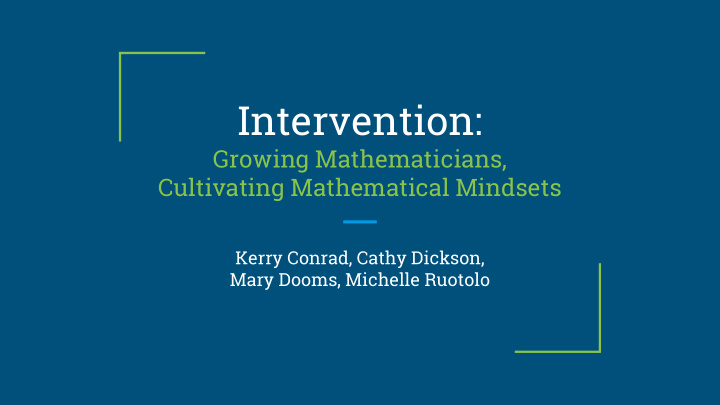



Intervention: Growing Mathematicians, Cultivating Mathematical Mindsets Kerry Conrad, Cathy Dickson, Mary Dooms, Michelle Ruotolo
Learning Goals ● Share the beliefs and strategies that drive our model of math intervention Growth mindset ○ ○ Co-teaching * An area of strength ○ Assessment Capable Learners ? An opportunity to learn Homeroom Support ○ After School Program ○ ○ Evening Webinars ● Provide inspiration for future intervention implementation
Session Norms courtesy ● Help one another to speak ● Welcome diversity ● Collaborate ● Bring a growth mindset ● Give and take ● Say the thing
Our Beliefs ● Cultivating a growth mindset contributes to personal and academic success ● Intervention is more preventative than prescriptive ● The use of formative assessment and feedback are opportunities for progress, not declarations of deficiency
Our School ● Lake Zurich Middle School North, northwest suburban Chicago ● Diverse student population of 700 students, grades 6-8 ● Twelve percent receive free or reduced lunch
Growth Mindset
Growth Mindset In other studies, researchers have shown that students' (and adults') mindsets can change from fixed to growth, and when that happens their learning approach becomes significantly more positive and successful (Blackwell et al., 2007). The highest-achieving students in the world are those with a growth mindset, and they outrank the other students by the equivalent of more than a year of mathematics. Boaler, J., & Dweck, C. (n.d.). Mathematical mindsets: Unleashing students' potential through creative math, inspiring messages, and innovative teaching .
Growth Mindset in the Classroom “Not Yet” ● “You can do this.” “This is important.” “I won’t give up on you.” ● Provide opportunities to: ● Take risks ○ ○ Make mistakes ○ Experience productive struggle Self assess ○ Relearn ○
Growth Mindset “The key growth mindset message was that effort changes the brain by forming new connections, and students control this process.” Boaler, J. (2013). Ability and Mathematics: The mindset revolution that is reshaping education. FORUM, 55(1), 143. doi:10.2304/forum.2013.55.1.143
Our Intervention Model Intervention as Prevention
Co-teaching Homeroom After School Evening Support Program Webinars
Co-teaching
Co-teaching Models ● Team teaching ● Parallel Teaching ● Alternate Teaching ● Station Teaching ● One teach, one assist
Dynamic Assessment and Feedback ● Assessments may be: ○ Informal (conversation, observation) ○ Formal (artifact, common assessments) ● Feedback must be: ○ Timely ○ Targeted ○ Specific
Habits of Assessment Capable Learners GOAL: To develop assessment capable learners ● From: “I don’t get it.” ● To: “This isn’t right, maybe if I create a table I’ll see a pattern.” From: “The table didn’t help me; I’m done.” ● ● To: “The table didn’t work; what do I do now?” From: “I’ll just look over my notes before the test.” ● To: “I better do a few practice problems.” ●
Visible Learning Research Hattie, J. (2012). Visible learning for teachers: Maximizing impact on learning . London: Routledge.
Self-assessment Artifacts by Brianna
For Discussion: - How do we encourage students to value reflection as a learning opportunity rather than a redundant task?
Homeroom Math Support
Homeroom Math Support Purpose: ● Reteach or preview the day’s learning objective ● Provide feedback and guidance with practice problems ● Review and reinforce prior learning
Homeroom Math Support Implementation: 1. Student identification a. Teacher recommendation b. Three year MAP data <30% 2. Parent notification of student eligibility Structure: Students attend for 30 minutes, twice weekly.
After School Program
After School Program Purpose: ● Focus on problem-solving skills and strategies using grade level standards
After School Program Implementation: Same criteria as homeroom support Structure: ● One hour, twice a week ● Sixth, seventh, and eighth grade groups ● Group size 3-8 students depending on the number of tutors
After School Program
Link to After School Curriculum http://bit.ly/2iM8QzS
For Discussion: - Share any constraints or obstacles your school has in implementing a homeroom math support or after school program. - How can we help each other overcome these obstacles?
Live, Evening Webinars
Live, Evening Webinars Purpose: ● An interactive learning session conducted via the internet ● Additional opportunity to reinforce current learning
The Compelling “WHY” Based on Old Dominion research (2015)... ● The findings suggest that the tutoring contributed to statistically significant gains in student assessment scores post-intervention. Chappell, S. L., Arnold, P., & Nunnery, J. (n.d.). An examination of an online tutoring program’s impact on low-achieving middle school students’ math achievement (Tech.). Retrieved August 4, 2016, from https://www.odu.edu/content/dam/odu/offices/tcep/docs/fev-tutoring-eval-tech-report-final.pdf
Live, Evening Webinars - Brief Video
Live, Evening Webinars Implementation: ● Students trained during math class Structure: ● 30 minutes, once a week per grade level
Co-teaching Homeroom After School Evening Support Program Webinars
Sample Intervention Results
For Discussion: - Describe and share other classroom structures that ensure students “get what they need.”
Co-teaching Homeroom After School Evening Support Program Webinars
Closing thoughts
Reflecting on our model ● Mindset shift from fixed to growth takes time ● Structure relies on voluntary student commitment ● Continuous teacher collaboration is necessary
Questions?
Intervention: Growing Mathematicians, Cultivating Mathematical Mindsets Kerry Conrad kerry.conrad@lz95.org Cathy Dickson cathy.dickson@lz95.org Mary Dooms mary.dooms@lz95.org Michelle Ruotolo michelle.ruotolo@lz95.org
Recommend
More recommend